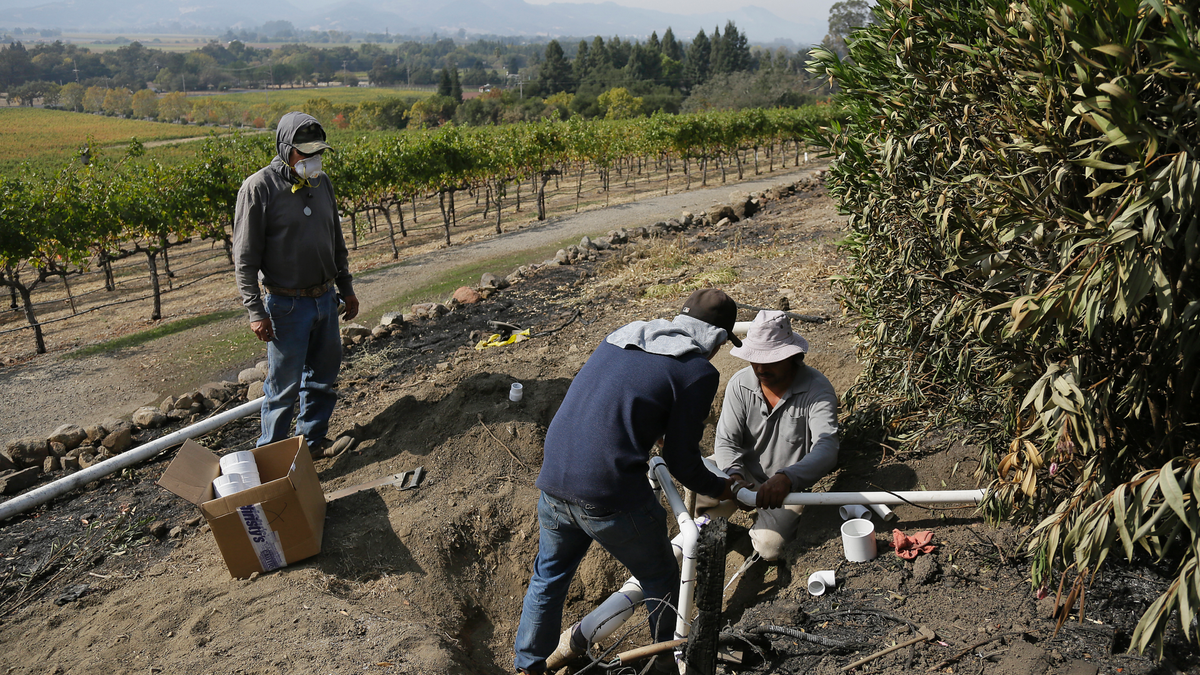
SONOMA, Calif. – Outside one of the first shops to reopen for business on an empty central square in California wine country, clerk Rhiannon Lorenzini swept the sidewalks as the sky cleared of ash more than a week after the state's deadliest group of wildfires ignited.
In a wine region that normally draws more annual visitors than Disney World, Lorenzini waved to some of the few passers-by: firefighters in firetrucks rolling through Sonoma's normally thronged 19th-century plaza. The blazes have left many business owners and employees without work or pay for nine days.
"I'm really grateful to be back at work, safe. And praying to have business here," Lorenzini said, as authorities began to lift evacuation orders this week and a utility restored power to more of the area, where fires have killed at least 41 people and destroyed thousands of homes and businesses.
"I do have bills coming up that I have to pay," said Lorenzini, who works at a home-goods store targeting visitors flocking to the more than 1,000 wineries in Sonoma and Napa counties. "You start to wonder how you're going to take care of yourself."
The fires up-ended business across wine country, forcing evacuations at some of the biggest employers, ranging from a sprawling state center for the disabled to department stores, hotels and wineries, shops and factories. Business communities were just returning Tuesday to assess the effect on revenue and jobs.
Wine tourism companies said customers were canceling almost all scheduled visits. Some businesses launched fundraisers for employees facing the prospect of long-term unemployment, including those who lost homes to the fires.
"It is hard to imagine that any significant level of tourism will resume anytime soon, despite that this is a magnificent time of year to be here," tour operator Don Rickard said.
California produces 85 percent of the country's wine, and Sonoma and Napa valleys make the highest-value bottles, according to the state's Wine Institute trade group. The valleys, linked by ridges now riddled with wildfires, provide the bulk of the state's 325,000 wine industry jobs and $58 billion in business for California alone, the group said.
Normally, the vineyards and wineries draw tens of millions of visitors each year and help support fast-growing communities on the edge of the San Francisco Bay Area.
For many teachers, store clerks and vineyard workers, however, costs are always high in the region with some of the most expensive housing in the country. The research group CoreLogic said median sale prices of a single-family home were $562,000 in Napa County and $577,000 in Sonoma County in August.
Francisco Macias, a landscaper in the city of Santa Rosa whose clients included a now-burned Hilton hotel, fled the fires last week. In the following days, Macias and his wife made the hard decision not to pay their mortgage when it came due.
"We figured we better have some money because we don't know what's going to happen," Macias said. "We didn't know how long it would be before we could work."
Unlike earthquakes that unleash destruction in seconds, the wildfires are dragging on, compounding worries for residents. In conversation, people talk first of their flight from their homes but increasingly turn to nagging thoughts of unpaid bills.
Adam Plasse, 18, of Santa Rosa, took day after day off from the garage where he works as an auto mechanic, forfeiting pay to try to defend his century-old house from the flames.
"I feel like I'm living in a matchbox, just waiting for it to ignite," said Plasse, who gave up the fight Saturday and fled with his girlfriend to a campsite on the coast.
With money dwindling, Plasse vowed to head back to work this week and drum up customers for the auto shop, even if his home burned to the ground in the meantime.
"I'm worried," Plasse said. "I can't miss too many paychecks."
Outside Sonoma, vintner Steve Larson pleaded with officials Monday to open one road so his workers could harvest, even as helicopters dropped water on the countryside nearby.
"I've got 100 tons of Cabernet grapes" ready for picking, Larson said. "That amounts to a lot of money for the company and for the 115 workers we have."
The fires were going to produce a painful "chain reaction" for people in the wine region, Larson predicted.
"We've been short housing as it is," he said. With thousands of homes burned, "where are these people going to stay, when there is no place to stay?
"They have bills to pay, they need gas for their cars, food on the table," Larson said.
By the fires' second week, winds that were lighter than feared and round-the-clock efforts by thousands of firefighters allowed authorities to start lifting closures that had kept out 100,000 residents and countless visitors.
Macias, the landscaper, got the call he had been waiting for. His bosses told him to show up for work Tuesday.
"That is the best news," he said. "Because we need the money."
___
This story has been corrected to reflect that the Wine Institute says there are 325,000 wine-related jobs in California, not 325 million jobs.





















